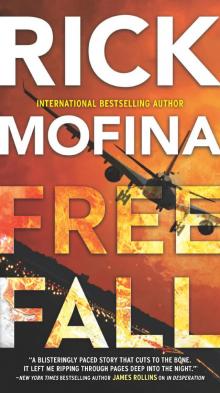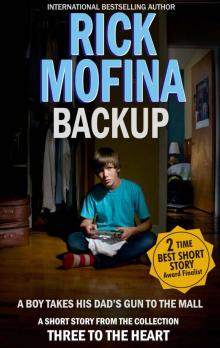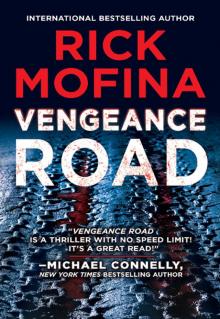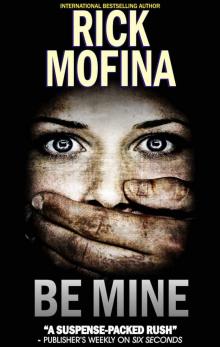- Home
- Rick Mofina
If Angels Fall (tom reed and walt sydowski) Page 6
If Angels Fall (tom reed and walt sydowski) Read online
Page 6
For nearly a year, fifteen volunteers, all parents of childrenwho had been killed, met on campus every other Saturday to discuss theirprivate torment. The corporeal and psychological toll of each child’s death wasalso measured in journals the parents keep.
Kate looked fondly at Angela Donner. The study wasborn with the murder of her-two-old daughter, Tanita Marie. Police had toldKate about a non-profit support group that was working with Angela Donner. Kateoffered counseling, to help her cope with Tanita’s murder. Then she becameconvinced more in-depth empirical studies were needed on the impact of childrenwho had died unnaturally.
She submitted a proposal for a research project, butthe university’s bureaucracy moved at a glacial pace. Despite cutbacks, she knewfunding existed. She lobbied the research committee. Eventually the committeemembers threw up their hands and found her some money-a fraction of what she’drequested-but enough for one year. Through the police, victims’ groups,personal ads, and notices posted around the campus, she found volunteersubjects for the project.
Now, with less than eight weeks remaining, when thestudy was beginning to bear fruit, the plug was going to be pulled. Kate wasconcerned. Patterns were emerging. She’d observed three, possibly four, distinctcycles, and in one case, an extremely unusually phenomenon that exceeded guilt.She was on the verge of understanding it and needed another year. But she wouldnot get another cent from the university. Despite accolades from somecolleagues, her request for more funding was denied and her work deemedredundant.
“Previous studies have clearly shown us the cycles youclaim to have found, Katie.” Dr. Joel Levine, the dean of psychiatry, advisedher to wrap up her research, as he cleaned his glasses with his tie. “You can’tperpetuate this artificial healing process for your group. It’s not fair tothem. Some in the department believe you’re using your subjects as acornerstone for a bereavement center. Write your paper, or a book, then moveon. Go out on a date. You know, you’re far more attractive than you allowyourself to be.”
Kate’s face reddened with fury, the same way it did atthe faculty Christmas party, when the eminent Dr. Levine, married father offour children, groped her breasts and suggested they slip away to “fuck likerabid mink” in the back seat of her Volvo.“Go to hell,” she hissed beforeslamming his office door, startling an undergraduate in the hall who droppedhis books.
As today’s session ended, Kate steepled her fingersunder her chin and informed the group that she had written to The SanFrancisco Star about the project with the hope that a sensitive articlewould give them positive exposure, and perhaps inspire the additional fundingthey needed to continue. She had violated university policy, but she didn’tgive a damn. It was a matter of survival.
That night, alone in her Russian Hill apartment,taking in her view of the Golden Gate, Kate agonized over her decision. Had shedone the right thing? Or was she reacting to Levine’s insult? She sipped aglass of white wine and continued reading files. She worried about each member.Most were healing, but she feared for those who might not recover. Ending thestudy now would mean irreparable damage. Anniversaries and birthdays wereapproaching-the most difficult times. It was coming up on one year sinceAngela’s daughter was stolen and killed. She was going to have a rough time.Then there was Edward Keller, her most unusual case.
She opened his file. An anniversary was coming up forhim. She flipped through her notes, handwritten on yellow legal pads, biting herlips, So many deaths in one incident. He was the most withdrawn group member.The others were referrals from police or victims’ groups, Keller was a walk in.He came to her office after a newspaper ad. A sober man with a whisperingvoice, he embodied pain.
His three children had drowned together in a boatingaccident. He nearly drowned trying to save them. He believed their deaths werehis fault. So did his wife, who left him six months later. His grief wentbeyond guilt and remorse. Kate worried about him. Privately, she advised him toget independent therapy. He was consumed with their deaths, even though theyhad died so many years ago. It might as well been yesterday. His was anabnormal case of sustained grief reaction. He relived the tragedy over andover, condemning himself, begging for another chance. She came to one page thatreminded her vividly of the night he stunned the group. She had written hiswords verbatim: “On certain nights, an energy flows through me, it’s hard todescribe, it’s extremely powerful, but I sometime believe I can bring themback, that it really is possible.” Flagging the note with an asterisk, she’djotted “Delusional” next to it. She flipped back to the beginning of Keller’sfile and checked the anniversary date of his children’s deaths. It was comingup. How was he going to survive?
Kate yawned, set her work aside, and switched on thelate night TV news. The top story was the kidnapping of Danny Raphael Becker.Next came footage of a helicopter hovering over the area, police officerssearching the neighborhood, some with dogs, Inspector Somebody saying that thepolice have no leads, frightened parents vowing to keep their children indoors.A picture of Danny Becker was shown for several seconds, and latter a pictureof Tanita, the reporter saying the police cannot rule out the possibility of alink between today’s case and Tanita’s murder, which remained unsolved. Katefeared for Angela. There was also some controversy over the Sunday schoolteacher who proclaimed his innocence, then committed suicide after he was namedas a suspect in Tanita’s murder. There was file footage of the man’s widowslapping the reporter who wrote the article for The San Francisco Star.Kate groaned. She had forgotten about the scandal over Tanita’s case. What wasshe thinking? Why didn’t she write the Chronicle or Examiner? What hadshe gotten herself into?
As the news droned, she thought of Danny’s parents,Angela Donner, and the people of her group. She switched off her TV, stared outat the San Francisco skyline. More Victims. Always more victims. Suffer thelittle children to come unto me, the malevolent deity.
She smelled mothballs and fresh, cold earth.
You are alone now, child.
I can bring them back.
NINE
Tom Reed was ninety minutes away from deadline when he returned to the star’snewsroom.
Bruce Duggan, the weekend night editor, leaned back inhis chair, entwining his fingers behind his head. His glasses rested atop hisforehead, which had encroached upon his hairline. His black eyes peered from awrinkled face that had settled into a permanent frown after twenty-five yearsin news. “Anybody else get the father, Reed?”
“No. It’s our exclusive. Cops sealed the house. Thefamily is holding a press conference tomorrow.”
Duggan thought, “Put the father up high. The art isstrong. It’s going A-1. Wilson filed a sider on Donner and some background foryou. I’ll ship it to you. Work in the Donner murder. Is there a link?”
“Nothing official yet.”
Duggan replaced his glasses and resumed working at hiscomputer. “I’ll need it fast to make first edition.”
At his desk Reed entered his personal code and histerminal came to life, requesting a story. He typed “KIDNAPPED.” A blackblinking cursor appeared, ticking off seconds on a blank screen.
Several floors below in the a paper’s basement, a crewof pressmen readied the Star’s Metroliner presses. Less than an hourafter they started rolling, sixty circulation trucks would rumble from theloading docks into the night, delivering a pound of information to threehundred thousand homes in the Greater Bay Area.
Reed’s story would be on the front page, above thefold.
The third paragraph of the story described policecombing the area, that an expanded full-scale search for Danny and his abductorwas to resume Sunday at sunrise. Reed studied his notes for the strongestquotes from Nathan Becker, flagging the exclusivity of the interview:
“It happened so fast. I had only taken my eyes fromhim for a few seconds,” Nathan Becker, 35, told TheSan Francisco Star minutes after he stopped his southbound BART train tochase the man who kidnapped his son…
Reed brought in Sydowski, identifying him as theprimary detectiv
e in the Donner case, who was now helping on Danny Becker’sabduction, and disclosing that Sydowski had refused to link the two cases.
Reed glanced at his watch, typed a few commands, andcaptured the background written by Wilson. It began:
Last year two-year-old Tanita Marie Donner’s bodywas stuffed into a garbage bag hidden under a tire deep in a secluded woodedarea of Gold Gate Park. Her killer remains free.
“Excuse me?”
Tad Chambers, an eighteen-year-old copy runner, stoodbefore Reed, tapping a pen on his palm. “I’ve got this woman on hold who reallywants to talk to you. Asked for you specifically.”
“Take her name and number.”
“She won’t leave her name, says it’s about the Donnermurder.”
The Donner murder? Probably a crank. He’d receiveddozens of nut calls last year when the story broke. Today’s news of the Beckerkidnapping was exciting the crazies; He should talk to her, just in case.That’s how he had gotten the Wallace tip.
“Okay, put her through.”
Tad disappeared across the newsroom. Then Reed’s linerang.
“Reed.”
“You wrote about the girl murdered last year, TanitaDonner?”
“Look, I’m on a deadline. Please give me your name andnumber and I’ll call you right back.”
“I don’t want my name in the paper.”
“Listen ma’am-“
“What I have to tell you, I have to say now, while I’mup to it.”
“I won’t talk to you unless you tell me who you are.You know how people accuse us of making things up.”
She gave it some thought: “Florence.”
“Got a last name, Florence?”
“Just Florence.” She sounded grandmotherly, earlysixties, working class, probably watched soaps and game shows all day.
“Why are you calling, Florence?”
“You know about that little boy who was kidnappedtoday, how they’re saying it’s just like that little baby girl who got murderedlast year, but they don’t know who did it?”
“Go ahead.”
“I know who killed her.”
Sure you do, dear. “What’s the killer’s name?”
“I don’t know his real name.”
“Look, I’m really-how do you know this guy’s thekiller?”
“I heard him confess. He said he did it and no oneknows.”
“Really? Did you tell the police?”
“I called them. They said they needed more specificinformation from me. But they never came around. Never talked to me. So whenthat little boy got kidnapped today, I decided to call you.”
She continued. “I love crime stories. I read all thepapers. Yours are the best, except for that mistake you made about the Sundayschool teacher being the killer.”
“The Sunday school teacher didn’t kill Tanita Donner?”
“Well, not by the way the real killer talks. I wantedyou to know what I heard, but don’t put my name in the paper. He scares me.”
“Do you think the killer also kidnapped Danny Becker?”
“What do you think? You’re a smart fellah.”
“How did you come to hear Tanita Donner’s killerconfess?”
A moment passed and Florence did not answer.
“Are you a clairvoyant, Florence?”
“A psychic? Who no, I’m a Roman Catholic. I sing inthe choir at Our Lady Queen of Tearful Sorrows.”
“That’s lovely, Florence. Listen, I’m really sorry butunless you can be more specific-“
“I heard him tell God he did it.”
Under R, religious nut: bingo?
Suddenly Duggan loomed over him.
“Fifteen minutes.” Duggan tapped his watch.
Again, he asked for her full name and number. Sherefused.
“I’ve got to go, Florence.” Just a lonely old woman.Reed hung up, finished the story, read it, then sent it to Duggan through thecomputer system.
In the washroom, Reed bent over a sink, and ran thecold water. His tip on Wallace had come the same way, but the guy who calledoffered something concrete he could check: Wallace’s conviction in Virginia.Reed confirmed it and Sydowski confirmed Wallace was the suspect. Didn’t he?That Wallace tip had to have come from a cop, the voice sounded like an oldsource, yet Reed couldn’t put a name or face to it. This Florence person was anut. “I heard him tell God.” Sure. But if Wallace killed Donner, why was thefile still open? Did the killer call Reed to set up Wallace? That wasSydowski’s thinking, but Reed couldn’t accept it. For it meant the real killerwas still out there. And now, with another child abduction, and in Balboa, itmeant another child may be murdered and that he may have truly contributed tothe death of an innocent man.
He splashed his face until he washed the fear from hismind.
The few strands of gray invading the temples of hisshort brown hair were multiplying. He was thirty-three. Thirty-three and he hadnothing. Nothing that mattered. Nothing but his job, self-doubt, and anincreasing affection for Jack Daniel’s Tennessee Sipping Whiskey. When Annleft, she opened the door to a dark truth, showing him exactly what he was. Onthe way back to his desk, Reed saw Molly Wilson reading the memos posted on thenewsroom bulletin board.
“Hey, Tomster, finish the story?”
“Why haven’t you gone home yet?”
“Didn’t feel like it. Feel like a beer?”
“I am tired. It’s been a long day. Can I take a raincheck?”
Molly stepped closer. He could smell her perfume.“I’ve given you a handful already, Tommy. When are you going to put them touse?”
He liked her perfect-teeth smile, her ice-blue eyesinviting him to a place he as tempted to enter.
“See this?” A perfect fingernail tapped a memo. “Couldbe exciting, don’t you think?” Molly said before leaving.
It was a managing editor’s notice calling forapplications for the paper’s new South American bureau in Sao Paulo. Reedtook five seconds to ingest the idea of applying and the consequences ofsuccess before returning to his desk for his jacket.
“Any problems?” he asked Duggan on his way out.
“Good piece. Just in time for first.”
“I’ll cover the Becker press conference tomorrow?”
“No, you’re working the night shift in here tomorrownight.”
“But I’m the lead report on this one.”
“Benson called in the order. You’re off the story.”
Myron Benson, the editor of the paper’s largesteditorial department, controlled fifty reporters. Invoking Benson’s name gaveany instructions immediate currency. Duggan stared at Reed. No elaboration wasneeded. The fuckup last year, and that Benson had nearly fired him and kept himon indefinite probation were known facts.
“Fine, fine. I get it.”
Duggan gave him an opened business envelope addressedto the paper. It bore Metro University’s seal and came from a Dr. K.E. Martinof the psych department. Reed’s name had been scrawled on it.
“What’s this?”
“Benson wants you to do a feature on this bereavementgroup.” Duggan nodded at the envelope. “He wants you to tie it in with theanniversary of the Donner murder and the Becker kidnapping.
Reed was wounded. Again. He swallowed it.
“Sure. I’ll get right on it.”
Crumbs and crap, that’s what they were feeding him.Reed tucked the envelope into his jacket and headed for the parking lot.
TEN
The distant horn of a tug echoed from the bay as Tom Reed walked across the Starparking lot. Cool Pacific breezes carried the stench of diesel and exhaust fromthe freeway overhead. The green ’77 Comet he had bought after Ann left waitedlike a lonely, faithful mutt.
Reed lost his awe for San Francisco- the lights ofCoit Tower, the financial district, the pyramid, the hills, the bridges, theBay.
He ran a red light entering Sea Park, a community ofuphill mansions whose views rivaled Russian Hill and Pacific Heights. Itbordered a small park dotted b
y stone tables topped with permanent chessboards.Old European men brought their own worn pieces here to play friendly games andreminisce. Beyond the houses were rows of condos. A sedate community. GleamingJaguars, BMW’s and Mercedes lined the streets. Precision clipped shrubs andhedges hid the pong of tennis balls, the splash of a private pool, andthe occasional whispered investment tip.
Reed parked near the three-story Edwardian house wherehe lived with five other men. The owner, Lila Onescu, was a Rumanian grand damewith gypsy blood who lived in a condo two blocks away. After Ann left withZach, Reed couldn’t bear living alone in their house. A buddy told him of LilaOnescu’s place, a jewel in Sea Park, well kept, quiet. A hundred bucks a weekfor a room on the second floor where he would share a bathroom and kitchen withtwo tenants. This was his home.
Reed creaked up the staircase, welcomed by the typednote taped to the door. “Where is the rent? L. Onescu.” He was two weeksbehind. He would give her a check tomorrow he promised, fumbling for his key.
His room had three bay windows overlooking the MarinaDistrict and the Pacific. A dorm-style single bed with rumpled sheets wasagainst one wall. A mirrored dresser stood against another near an ornamentalfireplace. A small desk sat opposite the bed, and a tattered, comfortable sofachair was in the middle of the room, which had hardwood floors and faded greenflower print wallpaper. Reed’s framed degree, his two awards, a Starfront page, and silver-framed pictures of Ann and Zach, were leaning on thefireplace mantel, hastily placed in the hope they would be collected at amoment’s notice. A stack of newspapers tottered a few feet from the floor nextto the dresser. It had started growing the day he moved in-three weeks afterAnn moved out of their bungalow in Sunset. When she left, their house hadbecome a mausoleum for their marriage. He had to leave, or be entombed. Theyagreed to rent their house.
Reed went down the hall to the kitchen for ice. In hisroom, he poured some Jack Daniel’s, striped off his clothes, casting them ontothe pig-sized heap in the corner, slipped into jogging shorts. He opened thebay windows and watched the twinkling lights of the Golden Gate.

 The Only Human
The Only Human Tom Reed Thriller Series
Tom Reed Thriller Series![[Tom Reed and Walt Sydowski 04.0] No Way Back Read online](http://i1.bookreadfree.com/05/tom_reed_and_walt_sydowski_04_0_no_way_back_preview.jpg) [Tom Reed and Walt Sydowski 04.0] No Way Back
[Tom Reed and Walt Sydowski 04.0] No Way Back Missing Daughter
Missing Daughter Their Last Secret
Their Last Secret Jason Wade - 02 - Every Fear
Jason Wade - 02 - Every Fear In Desperation
In Desperation Every Second
Every Second Full Tilt
Full Tilt Search for Her
Search for Her The Last Pursuit
The Last Pursuit Every Fear
Every Fear Last Seen
Last Seen The Panic Zone
The Panic Zone The Panic Zone jg-2
The Panic Zone jg-2 Free Fall
Free Fall Blood of Others
Blood of Others![[Jason Wade 02.0] Every Fear Read online](http://i1.bookreadfree.com/i1/03/31/jason_wade_02_0_every_fear_preview.jpg) [Jason Wade 02.0] Every Fear
[Jason Wade 02.0] Every Fear Backup
Backup Perfect Grave
Perfect Grave Into the Dark
Into the Dark Whirlwind
Whirlwind Perfect Grave jw-3
Perfect Grave jw-3 If Angels Fall (tom reed and walt sydowski)
If Angels Fall (tom reed and walt sydowski) Six Seconds
Six Seconds If Angels Fall
If Angels Fall They Disappeared
They Disappeared Vengeance Road
Vengeance Road Before Sunrise
Before Sunrise A Lifetime Burning in a Moment
A Lifetime Burning in a Moment Blood Red Rings (Dangerous Women & Desperate Men)
Blood Red Rings (Dangerous Women & Desperate Men) As Long As We Both Shall Live (Dangerous Women & Desperate Men)
As Long As We Both Shall Live (Dangerous Women & Desperate Men)![[Tom Reed and Walt Sydowski 01.0] If Angels Fall Read online](http://i1.bookreadfree.com/i2/04/12/tom_reed_and_walt_sydowski_01_0_if_angels_fall_preview.jpg) [Tom Reed and Walt Sydowski 01.0] If Angels Fall
[Tom Reed and Walt Sydowski 01.0] If Angels Fall Cold Fear
Cold Fear Be Mine
Be Mine Three Bullets To Queensland
Three Bullets To Queensland